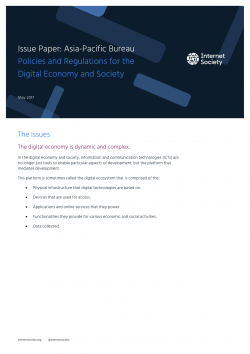The Issues
The digital economy is dynamic and complex.
In the digital economy and society, information and communication technologies (ICTs) are no longer just tools to enable particular aspects of development, but the platform that mediates development.
This platform is sometimes called the digital ecosystem that is comprised of the:
- Physical infrastructure that digital technologies are based on.
- Devices that are used for access.
- Applications and online services that they power.
- Functionalities they provide for various economic and social activities.
- Data collected.
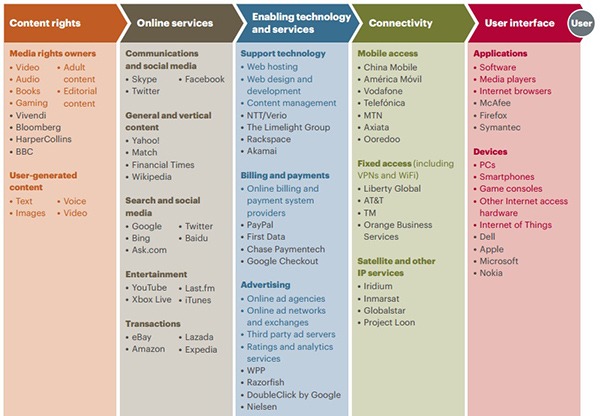
Source: A.T. Kearney, “The ASEAN Digital Revolution,” 2015
Policies and regulations play a crucial role in creating a digital economy and society, and must tackle a complex set of challenges
To transition to a digital economy and society, policies and regulations need to address a complex set of barriers related to: (1) connectivity (fixed and wireless); (2) affordability of devices and connection plans; (3) digital literacy; (4) locally relevant content and applications; (5) security and privacy; and (6) enabling entrepreneurship and an online business environment.[1]
In Bangladesh, the launch of the 2009 ICT Policy and the 2009 Broadband Plan led to an increase in the number of Internet users. But the exponential increase came when the government licensed five operators to provide 3G services in 2013, increasing broadband connection by eightfolds in two years. Bangladesh’s policy has focused on reducing supply- side costs of international and national connectivity, but with less emphasis placed on demand-side barriers, such as affordability, relevance and capability, the usage of the Internet remains low in Bangladesh, with just 14.4% of the population online in 2015.[2]
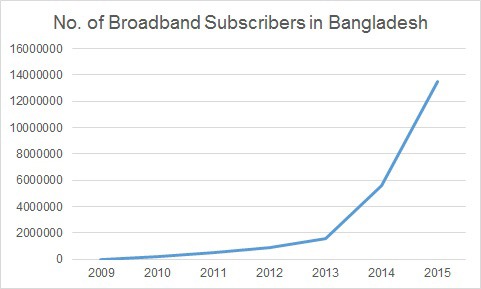
Source: A4AI, “Realising Affordable Internet in Bangladesh: A Case Study,” June 2016.
This example illustrates two common trends that are taking place in emerging economies in the Asia-Pacific region:
- Regulations to make 3G and 4G services available result in exponential increase in access to the Internet through mobile broadband.
- The focus on supply-side barriers, with lesser emphasis on addressing demand-side issues, means that the usage of the Internet remains low.
Policymakers and regulators must work with a more varied group of service providers.
The digital ecosystem has allowed new players to enter markets. For example, the finance and banking sector has evolved from state banks, non-governmental organizations, microfinance institutions and cooperatives, and insurance companies to a broader range of providers that now includes mobile network operators, payment companies, and e-commerce and Internet companies. The challenges that policymakers and regulators need to tackle in enabling digital finance include the following:
- Innovative digital financial services typically involve multiple providers that will be storing and managing customer’s data and funds. There may be risks related to real- time accuracy and reconcilability of records.
- When products are bundled, regulation and monitoring becomes more complicated, requiring coordination among providers and regulators.
- There is a need to ensure fair play among both bank and non-bank providers.
- Agents and agent networks, the customer interface for digital financial services, introduce new risks including fraud, agent error, poor cash management by the agent and poor data handling.
- The quality and reliability of the ICT infrastructure and system affect the risks of disrupted service and lost data, and risk of privacy or security breach.
- In the event the consumer suffers a loss, liability can be unclear due to the multiple providers involved in service delivery.
Interoperability and interconnectivity are paramount when transitioning to a digital economy and society
To transition to a digital economy and society, policies need to encourage the:
- Interconnectivity of networks – so any user of one network can communicate with any user of another.
- Interoperability of systems, applications and content – so they can be used across networks, and give rise, for example, to content sharing and collaborative working.
The importance of interconnectivity and interoperability is that, once established, they open the way for, and encourage, additional innovative services, content and applications.[3] For example, payment networks have begun to interconnect with mobile networks, and are stimulating a range of entrepreneurial activities and innovations.
In Afghanistan, M-Paisa—a mobile money operator—can be used to borrow money to buy fertiliser, pay for health care, and save money for education. However, all mobile money operators in Afghanistan have launched their own payment services with no interoperability enabled between them. The lack of interoperability has only served to fragment the nascent market, and hinder the generation of critical mass for sustainable digital payment services.
In Indonesia, in May 2013, three major mobile operators—Telkomsel, Indosat and XL—jointly made their mobile money networks interoperable. This is one of the first examples of its kind anywhere in the world.
Interoperability is also important for the stability and reliability of the network. Government and business decisions should consider open standards and the open Internet model.[4]
There is lack of regional cooperation in addressing transnational challenges.
The transnational nature of the digital economy challenges policies and regulations related to taxation, trade, labour, consumer protection, privacy[5] and security, and multilateral dialogue and collaborations will be necessary to harmonize standards, policies and regulations.
Cybersecurity is an area that clearly requires cooperation in information sharing, coordination in incident response, and the development of common standards and approaches to cybersecurity that do not inhibit innovation, economic growth and social progress. Countries from the Asia-Pacific region have been focused on improving their national cybersecurity regulation with more stringent regulatory requirements, but there is yet no clear pathway towards regional conformity.[6]
Gender equality is not an explicit priority in national broadband and digital economy policies.[7]
There has been a growing trend towards the development of comprehensive national broadband policies that are essential for creating the foundation for a digital economy and society. However, very few policies are gender responsive. Only 10 out of 109 countries covered in the 2013 Broadband Commission Working Group on Gender Report have policies that include references to gender. Only three are from the Asia-Pacific region—Bangladesh, India and Japan.[8]
It is recommended that policies for ICT, broadband, cybersecurity and privacy include specific, time-bound targets to close the gender digital divide. These policies should be developed in consultation with women’s organization, and backed by adequate budget allocations and the collection of gender-disaggregated data for monitoring progress.[9]
The Opportunities
Good policy and regulatory practices to improve and extend connectivity, particularly in rural and underserved areas, are available.
Policies that stimulate competition in the telecommunication sector has played a crucial role in increasing investments in every layer of the connectivity market, to improve and extend the ICT infrastructure, foster innovation and drive prices down.
But in many countries in the Asia-Pacific region, people living in rural and remote regions are not connected because they are not commercially viable for service providers. Policies need to enable a more diverse group of players to build the required ICT infrastructure and to maximize the use of existing resources e.g., through infrastructure sharing.
Community networks
The latest Affordability Report[10] calls for policies that promotes public access solutions, including subsidized access in schools and local centres, public Wi-Fi and community networks. Many public access facilities also often offer digital skills training, which in turn can promote local content development and stimulate greater demand for online services.
Public access brings to mind the “telecentre movement”, which in the 1990s, saw thousands of facilities established worldwide. However, many telecentres fell out of use after a few years, often because they were unsustainable. In response, community networks have emerged as a means to provide public access sustainably, particularly for rural communities.[11]
The Internet Society’s Wireless for Communities (W4C) programme uses low-cost wireless technologies and unlicensed spectrum to create community-owned and community- operated networks in rural and remote locations.[12] These networks have created village-level digital enterprises and enabled the creation of locally-relevant applications and content.
W4C Ecosystem
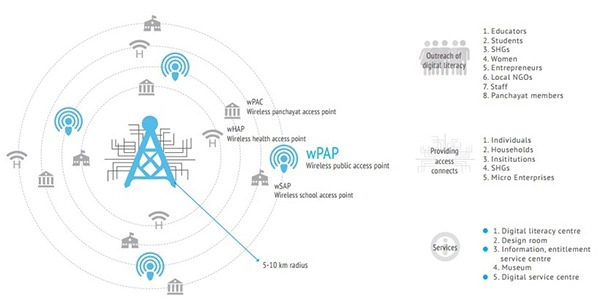
Source: Digital Empowerment Foundation, “Wireless for Communities”
Key recommendations from the W4C Summit in 2014 include the following:[13]
- Delicense more spectrum resources and make them freely available to civil society organizations for providing connectivity to rural and remote areas, with suitable policies to restrict and penalize their misuse.
- Promote rural Internet service providers (ISPs) as a sustainable social enterprise, review the licensing system to enable the establishment and operation of rural ISPs, and review arrangements for infrastructure sharing and revenue sharing with larger ISPs.
Spectrum policy
As many first-time users are going online via mobile devices, governments need to adjust their digital economy policies accordingly, including the ways in which spectrum is allocated and managed. Telecom operators need sufficient spectrum to enable effective provision of mobile broadband infrastructure and services. When countries release spectrum using a harmonized band plan, the mobile industry would benefit from economies of scale and keep prices low for end users.
The Asia-Pacific Telecommunity (APT) 700MHz band plan, optimized for 4G mobile broadband services, has been adopted as a standard by the international 3rd Generation Partnership Project. Countries like Australia, Brunei, China, India, Indonesia, Japan, Malaysia, New Zealand, Papua New Guinea, Republic of Korea, Singapore and Tonga have committed to align with the APT 700MHz band plan. The South Asia Telecom Regulatory Council has also announced the adoption of the plan.[14]
Generally, it is recommended that a regulator independent of the government implements the spectrum assignment and that the spectrum rules are created to ensure the operators have access to[15]:
- The right type of spectrum and the right combination of frequency bands (e.g. the contiguous 700MHz band)
- Sufficient spectrum (20MHz per operation per country is recommended)
- Affordable spectrum
- An efficient, fair, and transparent allocation process
Infrastructure sharing
In building the ICT infrastructure, civil works such as ducting, excavation and the physical infrastructure are the dominant cost items, typically representing about 80% of the total cost.[16] Many countries are promoting the sharing of resources such as towers and ducts, and laying fibre cables with other infrastructure such as roads and power lines. India was one of the first countries to modify license conditions to allow infrastructure sharing in 2007, which contributed to a 75% growth in 3G coverage between 2010 and 2015.[17]
Universal service fund
Regulators have established universal service funds (USFs) as a financing mechanism to spur ICT investment and expansion in rural and underserved areas, using levies collected from operators.
A 2013 GSMA report revealed that across the world, more than half of the sums collected for USFs were never utilized, and over a third of the funds were not able to distribute any of the levies.[18] This calls for a review of its policies and mechanisms, as there have been some positive experiences. An International Telecommunication Union (ITU) report that studied USFs in 69 countries, 16 from the Asia-Pacific region, has collated some critical success factors in the management of USFs.[19]
According to the report, the Asia-Pacific is one of the leading regions in which there is a comparatively higher level of activity amongst the funds. The region also displays a greater focus than other regions on the deployment of broadband through the use of USFs, and on considerations of digital inclusion with initiatives targeted at women and persons with disabilities, although the report notes that much more needs to be done. Due to the complexity of the digital ecosystem, USFs have recently been used to create demand through strategies for affordable devices (e.g., discounts, payment options), subsidies for subscriptions, training and local content development.
The active USFs in the Asia-Pacific region include Afghanistan, Australia, India, Indonesia, Malaysia, Mongolia, New Zealand, Pakistan, Thailand and Viet Nam.[20]
There is potential to further drive down cost to enhance affordability.
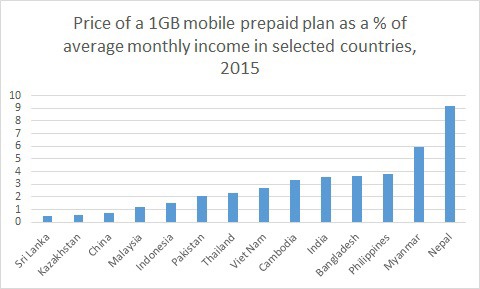
Source: A4AI, “2017 Affordability Report, 2017
A4AI conducted a research to show that the current United Nations definition of “affordable” basic broadband (a 500MB allocation of prepaid mobile data at a cost of 5% of average monthly income) is actually unaffordable to 40-80% of the population in many developing countries. The A4AI recommends that governments pursue a more ambitious affordability target of 1GB of prepaid mobile data at less than 2% of average monthly income.
Some countries impose significant import tariffs on digital technologies, which increases the cost of these technologies for users. In Viet Nam, reduction in mobile taxation from 10% in 2011 to 0% in 2014 resulted in: (1) 7 million more mobile Internet subscribers; (2) 47% increase in smartphone connections; and (3) 41% growth in active social media accounts (compared to 2013 figures).[21]
The dominance of the market by incumbents places burdens on the market and consumers. Introducing competition will increase accessibility and lower prices. Market diversification or the creation of an enabling environment for new businesses and new business models to emerge will also increase access and drive down costs.
Regulatory reform can enable innovation and investment in the local digital economy.
The Internet has created a new wave of innovation and entrepreneurship. Internet companies now compete with traditional players in banking, insurance, retail trade, transport, logistics, international currency transfers, accommodation, tourism, media, advertising, etc. It has been recommended that governments abstain from imposing regulatory barriers on new Internet companies until they achieve a certain scale.[22]
At the same time, there have been discussions for a “level playing field” among different actors in the digital ecosystem, and to maximize the investment capacity of different agents in the digital value chain, through adequate rules and the introduction of fair competition. Such calls usually refer to regulation of new entrants versus established incumbents, mobile versus fixed operators, and telecom operators and online service providers.
A typical example is telecom network operators being subject to strict regulatory requirements, such as licensing, interconnection charges, universal service levies, consumer protection, national tax regimes, etc. But big international over-the-top players that provide voice/communication services, such as WhatsApp and Skype, are usually free of such requirements. In Malaysia, domestic online purchases are subject to goods and services tax (GST). But, GST is not levied on goods purchased from international companies such as Amazon, Taobao and eBay.[23]
Countries are engaged in ongoing debates around the taxation policy surrounding these players. Australia has imposed a profit tax on multinational corporations with no taxable entity in the country, or those using connected entities and transfer pricing mechanisms to limit or avoid taxes. Japan has imposed a consumption tax for digital goods from overseas suppliers. Australia and the Philippines regulate online sharing services such as Uber and Airbnb to ensure consumer safety and bring them into the tax net.[24]
Opportunities are available to nurture talent for the digital economy and society.
A diverse field of expertise is required to build the network, and produce and manage the applications, content and services that underpin the digital economy and society. At the same time, it also requires that all participants, including consumers utilizing the digital services, possess a minimum level of digital literacy.
Targeted training for different groups of people, including policymakers and regulators is recommended in many studies.[25] In the long-term, investment in primary to tertiary education to nurture the technical skills, as well as “21st century” skills”,[26] is also recommended.
The United Nations Asian and Pacific Training Centre for Information and Communication Technology for Development (UN-APCICT) has been taking the lead in enabling ICT capacity building for different groups, including government leaders, higher education institutions and youth, and women’s entrepreneurs. UN-APCICT’s capacity building programmes specifically focus on how these targeted groups can effectively use ICT for economic and social development (and not just entertainment).[27]
The Academy of ICT Essentials for Government Leaders programme has been launched in 30 countries. Countries including Lao PDR, Myanmar and the Philippines have integrated the Academy training modules in their training programmes for government officials. In Myanmar, for example, the Academy programme is part of an eight-week government executive officials’ management course conducted annually by the Union Civil Service Board.[28]
Providing a supportive ecosystem for frugal innovators and women entrepreneurs to use ICT for economic and social development is another critical area for policymakers to consider, including diversifying access to funds, increasing the ease of establishing startups for frugal innovation and women’s entrepreneurial activities, and providing support for incubation and scale up.[29]
Alignment with the SDGs
Towards a digital economy and society, the SDGs commit United Nations member states to:
Enhance the use of enabling technology, in particular information and communications technology, to promote the empowerment of women (SDG5b).
Significantly increase access to information and communications technology and strive to provide universal and affordable access to the Internet in least developed countries by 2020 (SDG9c).
By 2030, ensure that all men and women have equal access to basic services and appropriate new technology (SDG1.4).
Questions to Think About
What are the strategies for crafting policies that are proactive in supporting a digital economy and society, rather than merely reacting to its effects?
What is the most suitable regional forum and collaboration mechanism to harmonize policies, regulations and standards and collectively address transnational issues?
How can digital literacy skills of underserved communities (e.g. rural areas, senior citizens) be improved so that they can better participate in the digital economy? When should schoolchildren be taught digital literacy?
How can we build a culture of innovation, creativity and entrepreneurship such that people from all levels of society are able to pursue opportunities with the digital economy?
What are the metrics for access and affordability that allow a person the ability to fully participate in the digital economy? What data speed and at what cost? How about the device being used?
Endnotes
[1] Please refer to the Internet Society Policy Framework for Enabling Internet Access (http://www.internetsociety.org/doc/policy-framework-enabling-internet-access). This issues paper builds on the framework, and discusses the challenges and opportunities specific to the Asia-Pacific region. See also the issue papers on “Rural Connectivity” and “Enabling e-Services” that introduce these key barriers to Internet access in the Asia-Pacific region, with examples of what can be done to address these barriers (see https://www.internetsociety.org/ridd/apac/). This issues paper focuses on ways to enable the implementation of innovative solutions, specifically through policy and regulatory changes, so that everyone can fully leverage the Internet to develop their economy and society.
[2] Since the country has one of the highest tax rates for mobile services in the world, policy and regulatory reform on Bangladesh’s taxation has been recommended in a number of studies. See Alliance for Affordable Internet, “Realising Affordable Internet in Bangladesh: A Case Study,” June 2016; and GSMA, “Digital Inclusion and Mobile Sector Taxation in Bangladesh,” March 2015, http://www.gsma.com/publicpolicy/wp-content/uploads/2012/03/Digital_Inclusion_and_Mobile_Sector_Taxation_in_Bangladesh_WEB_FINAL.pdf
[3] For more details about interconnectivity and interoperability, see Internet Society, “Unleashing the Potential of the Internet for ASEAN Economies,” 2015, http://www.internetsociety.org/doc/unleashing-potential-internet-asean-economies.
[4] See Internet Society, “Open Internet Standards: An Internet Society Public Policy Briefing,” 30 October 2015, https://www.internetsociety.org/policybriefs/openstandards.
[5] For policies and regulations related to online privacy, see Issues Paper on Online Privacy.
[6] Mark Parsons and Harriet Pearson, “Cybersecurity Regulations in Asia: The Tightening Lines of Defense,” Hogan Lovells Chronicle of Data Protection, 8 November 2016, http://www.hldataprotection.com/2016/11/articles/cybersecurity-data-breaches/cyber-security-regulation-in-asia-the-tightening-lines-of-defense/; and Hogan Lovells, “Asia Pacific Data Protection and Cybersecurity Guide,” April 2016, http://www.lexology.com/library/detail.aspx?g=b7950c19-6a1f-45ee-ae69-5a05a65317dc
[7] See Issues Paper on Gender and the Internet.
[8] A4AI, “Affordability Report 2015/16,” 2015, http://a4ai.org/affordability-report/report/2015/
[9] Web Foundation, “Closing the Digital Divide: A Briefing Note,” 14 April 2016, http://webfoundation.org/2016/04/closing-the-digital-divide-a-briefing-note/.
[10] Alliance for Affordable Internet, “2017 Affordability Report, 2017, http://a4ai.org/2017-affordability-report/.
[11] Ibid.
[12] Internet Society, “Wireless for Communities,” https://www.internetsociety.org/what-we-do/where-we-work/asia-pacific/wireless-communities.
[13] Digital Empowerment Foundation and Internet Society, “4th Wireless for Communities & Open Spectrum Summit Report,” 2014, https://www.internetsociety.org/wp-content/uploads/2017/08/4th20W4C20Wireless20and20Open20Spectrum20Summit20report.pdf.
[14] Mark Vanston, “Asia Pacific Telecommunity (APT) 700 MHz Whitepaper, 8 May 2013, http://www.gsma.com/newsroom/wp-content/uploads/2013/09/Telstra-_-Asia-Pacific-Telecommunity-APT-700-MHz-Whitepaper-FINAL.pdf.
[15] A.T. Kearney, “The ASEAN Digital Revolution,” 2015, https://www.atkearney.com/documents/10192/6986374/ASEAN+Digital+Revolution.pdf.
[16] APC, “Unlocking broadband for all: Broadband infrastructure sharing policies and strategies in emerging markets,” April 2015, https://www.apc.org/en/system/files/Unlocking%20broadband%20for%20all%20Full%20report.pdf
[17] GSMA, “Closing the Coverage Gap: A View from Asia,” June 2015, https://www.gsmaintelligence.com/research/?file=e245c423854fcfd38eeae0a918cc91c8&download.
[18] GSMA, “Survey of Universal Service Funds: Key Findings,” April 2013, http://www.gsma.com/publicpolicy/wp-content/uploads/2013/04/GSMA-USF-Key-findings-final.pdf.
[19] International Telecommunication Union, “Universal Service Fund and Digital Inclusion for All Study,” June 2013, https://www.itu.int/en/ITU-D/Conferences/GSR/Documents/ITU%20USF%20Final%20Report.pdf.
[20] Countries where USFs are inactive include: Bangladesh, Cambodia, China and the Philippines.
[21] GSMA, The Mobile Economy Asia Pacific 2016 (2016), http://www.gsma.com/mobileeconomy/asiapacific/.
[22] World Bank, World Development Report 2016: Digital Dividend (Washington D.C., 2016), http://www.worldbank.org/en/publication/wdr2016.
[23] A.T. Kearney, “The ASEAN Digital Revolution,” 2015, https://www.atkearney.com/documents/10192/6986374/ASEAN+Digital+Revolution.pdf.
[24] Ibid.
[25] Carl Dahlman, Sam Mealy and Martin Wermelinger, “Harnessing the digital economy for developing countries, OECD Development Centre Working Paper No. 334, December 2016.
[26] See Glossary of Education Reform, “21st Century Skills,” http://edglossary.org/21st-century-skills/.
[27] A study by GSMA found that innovation using digital technologies has largely focused on entertainment. GSMA, “Mobile Internet usage challenges in Asia – awareness, literacy and local content”, July 2015.
[28] UN-APCICT works with higher education institutions to introduce ICT for economic and social development in the curriculum and research through its “Turning Today’s Youth into Tomorrow’s Leaders” programme; and works with women entrepreneurs and policymakers to promote economic and social development through the innovative use of ICT in the “Women and ICT Frontier Initiative. See United Nations Economic and Social Commission for Asia and the Pacific, “Report of the Asian and Pacific Training Centre for Information and Communication Technology for Development on its activities during the period 2014-2016,” 15 July 2016, http://www.unescap.org/sites/default/files/pre-ods/CICTSTI1_6E.pdf and http://www.unapcict.org.
[29] See Issues Paper on Frugal Innovation and Entrepreneurship.
